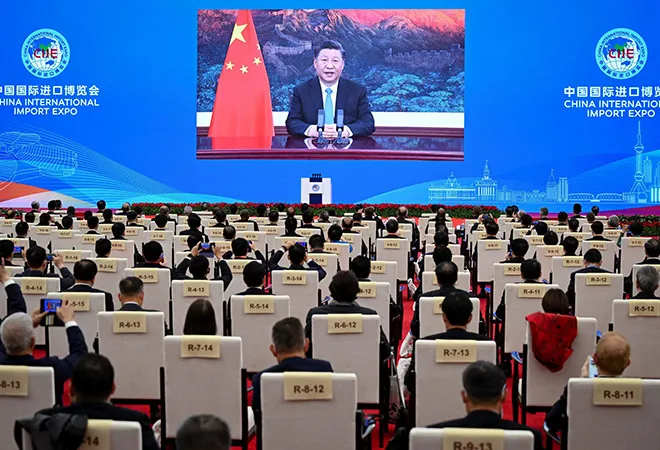
On 19 November 2020, China’s President Xi Jinping used the aegis of the Asia-Pacific Economic Cooperation (APEC) CEO Dialogues to signal an important recaliberation of his nation’s economy. The contours of the ‘dual circulation’ system that has been talked about in Chinese media are becoming a bit clearer.
Since Deng Xiaoping took over and adopted the policy of ‘opening up and reform,’ the People’s Republic became the second largest economy in the world in the last three decades by leveraging its model as a net exporter of goods. Under Xi, China’s planners seem to have come to the realisation that they must decrease their reliance on an export-oriented development strategy (or external circulation), without abandoning it altogether.
China’s ‘domestic market’ (guónèi shìchǎng — 国内市场) is to be a key component of this course correction for the following reasons:
Firstly, the Chinese economy has grown close to ¥100 trillion (approx. $15 trillion) with a per capita GDP exceeding $10,000, making China home to the world’s largest middle-income population.
Secondly, between 2016 and 2020, more than 60 million new employment opportunities were created in urban areas and over 50 million relocated from “unsuitable dwellings” into new homes in urban areas.
At a time when the US is trying to isolate China over the pandemic, the latter seems to be holding out an olive branch to other nations with President Xi saying, “China’s internal circulation will create more demand for a greater variety of quality products, technologies and services from across the world.”
At a time when the US is trying to isolate China over the pandemic, the latter seems to be holding out an olive branch to other nations.
The debate around ‘dual circulation’ stems from the premise that as an economy grows, domestic consumption will take centerstage, leading to a commensurate decline in the proportion of exports in China’s GDP. In October, the China's Communist Party plenum — the annual conclave of the elite Central Committee — met to thrash out its 14th five-year economic plan and deliberate on measures to “become the world leader in technological innovation” by 2035. Dual circulation became a key element of China’s economic strategy. Official documents alluded to “risks” and “external challenges” as the moving force behind dual circulation, pointing to China’s trade partners grappling with the pandemic and the resultant contraction in demand in these nations for China’s products. China’s mass manufacturing model also seemed to be under threat from US President Donald Trump’s trade war, his restrictions against Chinese technology companies like TikTok and Huawei, and curbs on semiconductor chip exports.
The action areas listed by the Central Committee include developing a modern industrial production system in China and upgrading the economic system. Given that China is still dependent in some sectors on Western technology, the strategy puts an onus on China’s modernisation through developing knowhow indigenously. Another priority is improving the innovation ecosystem through sustained human capital formation to reduce the reliance on the West. The Central Committee also turned its gaze internally and sought to create a robust domestic market and to improve income distribution particularly in the farming and rural sectors. The Central Committee had resolved to augment economic ties with the world that are beneficial to both parties.
The Central Committee also turned its gaze internally and sought to create a robust domestic market and to improve income distribution particularly in the farming and rural sectors.
Since dual circulation envisages a greater role for domestic consumption, it is important to boost incomes of the people and optimise income distribution. China seems to have zeroed in on a sector that has the potential to do that — a logistics and transportation network. The distribution of goods from the place where it is manufactured to the point of consumption is a critical factor of the GDP. Since development of the logistics sector has a bearing on land and labour, it has the capacity to impact employment and living standards.
Xi believes that an “efficient logistics system will be crucial” to both international and domestic circulation, and seeks to improve high-speed rail and international air freight transportation capacity. Plans are afoot to overhaul the transportation system consisting of expressways, highways, waterways, gas and oil pipelines by 2035. The new transport grid is expected to connect far-flung parts of China and boost connectivity within a province.
China seems to have zeroed in on a sector that has the potential to do that — a logistics and transportation network.
Incubation of innovation capabilities will again have an effect on income growth and building technological capacity through self-reliance. The development of Artificial Intelligence (AI) capabilities will feed into the priority sectors like logistics and the digital economy. The development of AI has become a field of interest with efforts to make China a centre for global AI technology by the next decade.
Allaying fears that China may isolate itself, the Chinese government has not completely abandoned ‘international circulation.’ The government will encourage small and medium enterprises with a “good track record” in manufacturing and clothing merchandise, and companies in new technologies like virtual reality, big data and 5G, to expand in the overseas market and encourage more foreign investment and free trade zones.
Xi has highlighted that there is a need for greater indigenous innovation.
To sum up, China realised that it has been over four decades since the ‘opening up and reform’ policies were implemented that have resulted in the economic transformation of the nation. However, the economic prospects of China’s trading partners seem bleak as they are still grappling with the pandemic, and the deterioration of its ties with the US has prompted the CCP to embark on a new development paradigm in which domestic and foreign markets complement each other, with the internal market as the main driver.
In many ways, ideas about dual circulation have been on Xi’s mind for some time. Since assuming office in 2012, President Xi has himself spelt out the need to improve living standards through provision of educational subsidies and creating an innovation-driven development strategy to boost the role of domestic consumption in the economy in his book The Governance of China. Xi has also highlighted that there is a need for greater indigenous innovation. This is now being felt as the US has put hurdles in the way of China accessing critical components.
China financial sector regulators have promised to create more avenues to channel investment from abroad into the capital market.
In making domestic consumption the main driver of economic growth, China believes that there will be more investment flows into its companies manufacturing consumer durables, given the size of its middle-income population. It believes that over a period of time, the fostering of an innovation-driven ecosystem will draw foreign capital to these companies. The Trump administration’s restrictions on semi-conductor exports to China have highlighted holes in the nation’s industrial capability.
China realises that it needs capital to realise these dreams, hence the groundwork has started in this regard. The conclave of Chinese bankers — Bund Summit convened in October 2020 — was aimed to showcase how China is “deepening its financial ties with the outside world.” China financial sector regulators have promised to create more avenues to channel investment from abroad into the capital market, and give foreign firms easier access to the country’s securities sector.
The 14th five-year plan of which dual circulation is a key element is expected to by approved by China’s National People’s Congress in March 2021.
The impact of homegrown-innovation may mean that in the coming years China is likely to reduce the imports in high-end manufacturing, which may cause alarm to South Korea and Germany. Commentators in the Chinese media say that the Chinese economy’s fundamentals have helped it weather the storm and make it the “only country in the world to achieve positive economic growth.” They also cite the World Economic Outlook Report prediction that China’s ‘consumer market’ is expected to reach ¥45 trillion — outstripping the US by 2021 — as the reason for their bullish sentiment.
The 14th five-year plan of which dual circulation is a key element is expected to by approved by China’s National People’s Congress in March 2021. However, the trajectory of the world’s second largest economy will be closely watched from now on.
The views expressed above belong to the author(s). ORF research and analyses now available on Telegram! Click here to access our curated content — blogs, longforms and interviews.




 PREV
PREV


